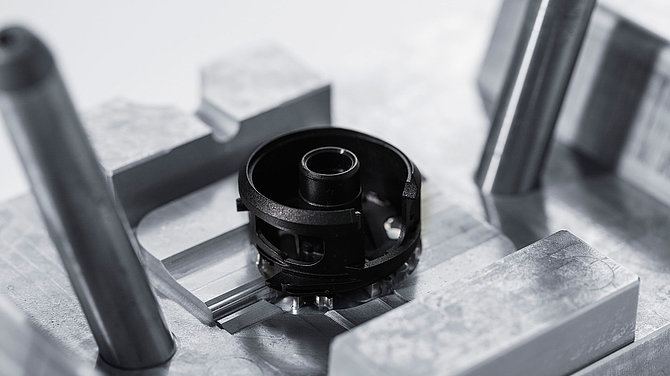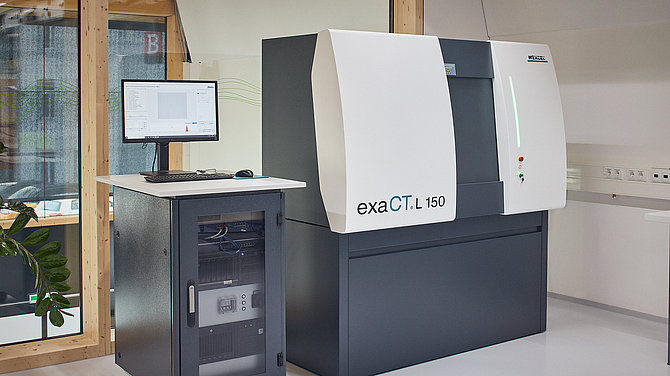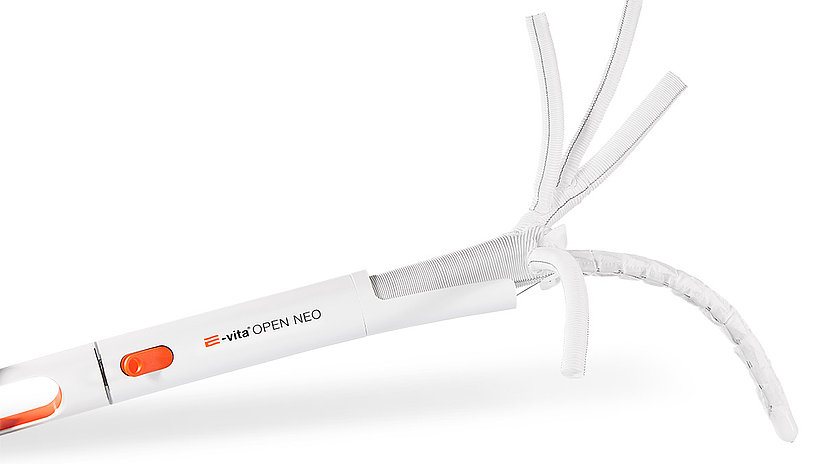BluSense’s BluBox is an easy-to-use, portable infectious disease diagnostic device. One drop of blood is enough to determine a person’s antibody levels. The analysis, which takes just seven minutes, requires disposable plug-in modules. These transparent “ViroTracks” measure nine by five centimeters and are three millimeters thick. They contain tiny microfluidic structures that are designed to transport minute quantities of liquid. For the complex diagnostic process to work correctly, maximum precision and cleanroom quality are essential.
1zu1 supported the development of these modules, which can test for COVID-19, from the initial designs through to the various aluminum injection molds and, subsequently, to the production-ready product.
John McCormack from BluSense and 1zu1 project manager Dario Loss share some insights into this project and explain the role of the computed tomography system, which was installed at 1zu1 in September, in the process.
Mr. McCormack, where did you first hear about 1zu1?
John McCormack: We were looking for a rapid prototyping company with injection-molding expertise and capacity for our initial development phase, which would involve low volumes with very strict requirements in terms of precision and quality. A former colleague recommended 1zu1 to me.
What happened from 1zu1’s perspective?
Dario Loss: BluSense’s tech-savvy staff approached us with some specific ideas and a realistic set of expectations. They wanted to find out what was feasible in injection molding within the scope of their design. In the course of the project and the steadily increasing requirements from the first prototype to the pilot series, we then successfully broke new ground in the areas of toolmaking, the manufacturing process, and metrology.
How did this result in even closer collaboration on the pre-series product?
John McCormack: Initially, we assumed that we would only use 1zu1 for the initial prototypes and then switch to another company for series production. But due to the challenging quality requirements and flawless collaboration, we decided to work with 1zu1 to produce a larger initial quantity of ViroTracks in the pilot phase. That was a key decision as it enabled us to bridge to future production runs of many million units per year. This seamless transition gives us a competitive advantage. Thanks to 1zu1’s capabilities, we didn’t have to jump straight from a few thousand to several million pieces. Instead, we were able to quickly produce several hundred thousand parts in series quality via a smooth transition. There was practically no loss of time from prototype to series product and we were able to launch the product a few months earlier than expected. That level of service really is unique in my experience.
What were the biggest challenges when developing and producing the ViroTracks?
John McCormack: The product underwent some very minor yet detailed iterations. The bigger challenge for us, however, was being able to track and understand their impact on the production processes. For example, choosing the right manufacturing strategy was enormously important with regard to the surface quality of the parts. Standard processes would not have got us to the desired goal.
Dario Loss: Getting the parts for the molding tools right was especially challenging. To achieve functioning microfluidics in the component via an injection-molded design, the smallest possible milling radii and locally sharp edges are required for the channels and transitions to the fluid reservoirs. The article design itself was already optimized as far as possible. So the finishing touches had to be applied via the manufacturing process. We therefore discussed every tiny detail. For this component, the specific focus was on identifying the functionally relevant elements, the minimum possible milling radii, and choosing the ideal milling strategy.
What other special features had to be taken into account?
Dario Loss: Due to the strict purity requirements in medical technology applications, the transparent plug-in modules must not contain any particles of foreign material. To guarantee this, we exclusively used one particular injection-molding machine for this article, as well as a hot runner with a valve gate nozzle – in use for the first time at 1zu1 – and a special surface coating for the aluminum molded parts. The production process was optimized to such an extent that manual contact with the components was no longer necessary.
Starting in September, measurements were taken at 1zu1 using the new computed tomography scanner. How did this new acquisition affect the project?
Dario Loss: A film containing information is welded onto the plug-in module, so there must be no unevenness, burrs, or deformations. Otherwise, weaknesses will be created during laser foiling. However, these critical points aren’t detectable using conventional measurement methods. CT was the only way we could carry out volume measurements of transparent components with
a precision as high as 5 micrometers. Previously, we had to rely on the customer’s welding results for feedback on minimal changes to the process.
How has BluSense benefited from its investment in computed tomography?
John McCormack: Our investment in testing and scanning technology has proved very beneficial for us. Based on the test data, we knew we didn’t need to invest as much in external quality assurance for our parts. Thanks to CT, we got more reliable data, a complete picture, and confidence in our work. Best of all, these measurements are part of an integrated service. It all happens dynamically at 1zu1 and saves us a lot of time.
How did your collaboration with 1zu1 develop?
John McCormack: Normally, we would have visited 1zu1 before the project started. That wasn’t possible due to the pandemic. Despite this, the project execution wasn’t a problem at all. The communication was excellent from day one and the extensive documentation allowed us to quickly and objectively assess the collaborative work. When we decided to take the next step and produce a pilot series, we were still on site at 1zu1 and so could witness their internal dynamics and high level of competence at first hand.
John McCormack is a project manager at BluSense in Copenhagen. Dario Loss is project manager at 1zu1 in Dornbirn. The interview was conducted by Joshua Köb; photos by Darko Todorovic.
![[Translate to English:] [Translate to English:]](/fileadmin/_processed_/9/b/csm_ViroTrack_finalproduct2_9072295958.jpg)

![[Translate to English:] Cleanroom production in accordance with ISO Class 8](/fileadmin/_processed_/c/d/csm_1zu1-Spritzguss-Reinraum2_fbc95a434a.jpg)


![[Translate to English:] High-End Spritzguss im Reinraum [Translate to English:] High-End Spritzguss im Reinraum](/fileadmin/_processed_/9/6/csm_2017_Reinraum-Teil_db82e327f5.jpg)
![[Translate to English:] [Translate to English:]](/fileadmin/_processed_/c/4/csm_20230315_DAT_0272_1200Px_3e60b5e8c8.jpg)